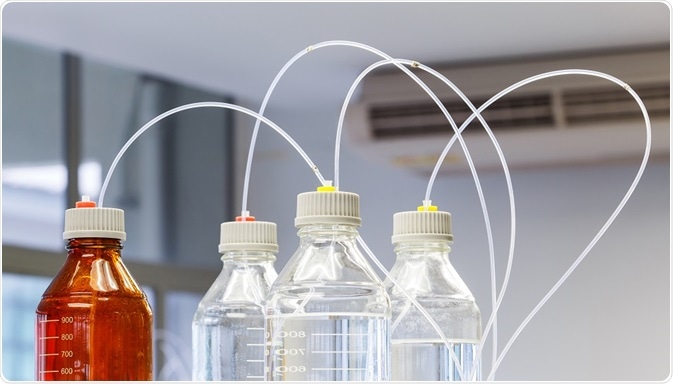By Jeyashree Sundaram, MBA
Fast protein liquid chromatography (FPLC) is a liquid chromatography technique for separation of protein molecules under pressure. It differs from high performance liquid chromatography in that the pressures are generally lower, around 435 to 580 psi, compared to 3000-to 5000 psi for an HPLC system.

Credit: 7th Son Studio/ Shutterstock.com
In this method, the composition of the mobile (liquid) phase is varied by using different proportions of components in the fluids that make up the eluent. The conditions of separation are maintained in such a way that when the composition of the eluent changes, there is a differential adsorption to the stationary (resin) phase of the components of the sample. Then the composition of the mobile phase is then changed again to let the molecule of interest desorb from the column and pass out with the eluent.
Principles and strategies in protein purification
The target protein may be a recombinant type or one existing naturally. It may or may not be tagged. It may be a soluble protein or it may be a membrane-embedded protein. The purpose of purification can be for structural or functional studies. Sometimes, the intent could be to use it for therapy or as a reagent. Depending on the scale, it may be analytical or preparatory. And each of these, in turn, may require different equipment. Despite these diversities, there are some common themes within the protein purification process.
When the protein of interest is a fusion protein (tagged naturally or otherwise), the specificity of interaction between biomolecules (e.g., between antigen and antibody, enzyme and its substrate) can be taken advantage of. Such molecules are purified and concentrated through a single-step affinity chromatography process, in which the protein is first selectively bound to the stationary phase and then eluted out. Sometimes, the tendency of the molecule to form a specific metal chelate can also be used achieve the same purpose.
The purification achieved by this process may be in the range of 70–95%. Often, higher levels of purity are required, in which case a multistep process is employed. The next step would be to use ion-exchange chromatography, a process where charge interactions between amino acids in the protein (say Glu, His, or Arg) and ligands in the stationary phase are used to selectively adsorb the protein of interest and allow the contaminants to pass through.
When the protein of interest shows hydrophobic interactions, another option such as reversed-phase chromatography can also be used to separate the protein from possible contaminants. The final (“polishing”) step is often size exclusion chromatography. In this method, smaller molecules get trapped within the pores of the stationary phase while the larger protein of interest passes through with the mobile phase.
Optimization parameters in protein purification with FPLC
The most common challenges in protein purification with FPLC revolve around maintaining the structure and functionality of the protein throughout the purification process. The main parameters that influence a protein’s integrity are pH, the buffering system, and salts.
The pH and the buffering system are related. The buffering systemprovides a pH that is close to the one in which the protein of interest normally is stable and soluble.
Phosphate, MOPS, and HEPES are commonly used buffers in FPLC.The general recommendation is that the buffer should also have a pKa that is within one pH unit of the desired pH. The concentration of a buffer also influences buffering capacity. About 50–100 mM is generally sufficient. It is equally important that the buffer does not interfere with the activity of the protein.
Salts such as NaCl (about 150 mM) or KCl (100–300 mM) are included in the buffers to mimic biological conditions and keep the protein soluble. But while moving from one chromatographic separation to another in the purification process, the salt concentration may vary, For example, , kept low (about 25 mM NaCl) with ion chromatography, but increased to more than triple (about 500 mM) with affinity or size exclusion chromatography.
Reducing agents (DTT, TCEP, 2-mercaptoethanol) are sometimes added to buffers to prevent protein oxidation and aggregation. Other additives used to increase protein stability include protease inhibitors (PMSF, pepstatin A), osmolytes (Triton X-100, NP-40), and metal chelators (EDTA, EGTA). But all these should be chosen with care. They should be used only when they are beneficial for the separation at hand.
Further Reading